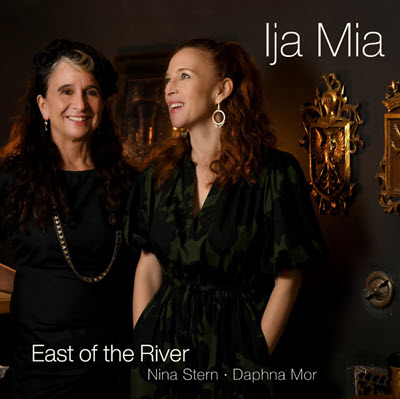by Aaron Keebaugh
Published May 27, 2024
Ija Mia: Music of the Sephardic Diaspora. East of the River, led by Nina Stern and Daphna Mor, recorders and other instruments. Avie AV2665
“Ija Mia,” the eponymous track on a new album from the New York-based ensemble East of the River, raises a curious predicament. A Jewish mother is attempting to marry off her daughter. But the daughter refuses each man in turn, even if they are tall and handsome. Giving in to her mother’s pestering or, more likely, as an act of sheer defiance, the daughter settles on a drunkard.

But given such outright hilarity, the music channels a surprising reverence, at least as performed by recorder players Nina Stern and Daphna Mor and the rest of their East of the River ensemble. It’s as if mundane and ephemeral experiences can be sacred, in and of themselves. That is but one takeaway from Ija Mia, a collection of evocative settings of Sephardic chants, songs, and dances that East of the River renders with soulful zest.
Such repertoire sits in a special place in the hearts of both Stern, who is of Venetian Jewish ancestry, and Mor, of Ladino heritage. With their cosmopolitan, multi-instrumental bandmates, Stern and Mor perform on recorders with as much flair as scholarly acumen. Arranged from the original sources, the music on this album offers only a glimpse into the rich repertoire of the Sephardic diaspora. But what an insightful and compact journey: Varying modal inflections recall influences as far afield as Spain, the Ottoman Empire, and Northern Africa, all regions where Sephardi Jews relocated after they were expelled from the Iberian peninsula between 1492 and 1497.
Yet what connects these musical threads — festively conveyed on this disc — are the myriad, gyrating rhythms that this repertoire absorbed from the local Arabic cultures. With that, the Piyyutim, a Sephardi liturgical genre, take on a seismic flair. And the Romanceros echo the lush sonorities of different makams and terkibs (Arabic modes).
As percussionists, Shane Shanahan and Zafer Tawil supply a propulsive oomph to make the acrobatic melodies of “Ein Keloheinu” into a joyful song of praise. Bassist Tal Mashiach grooves seductively in “Yigdal” while providing ample room for oud player Ara Dinkjian to deftly traverse its rhythmic sweep. Subtle tosses of the voice imbue Daphna Mor’s singing with just enough emotional gravity to make this prayer of thanksgiving into a personal plea.
The preview clip for East of the River’s third album, Ija Mia
Elsewhere, Mor’s clarion tone takes on hints of darkness. That allows for “Shir Hashirim,” a setting from Song of Songs, to convey all its rapt grandeur as the lines coil in soft arcs over a drone. All the while, the instrumentalists paint a vivid backdrop. On violin, Tawil spins delicate lines around Mor’s vocals in “Adio Kerida.” Stern’s chalumeau solo even brings an unexpected klezmer feel to “Porke Yorach,” a traditional Sephardic chant.
Dinkjian’s oud once again takes the spotlight in “Ashot Ketana” as the rest of the ensemble set the music turning about like a music-box figurine. “Oud Taksim,” with its improvisatory zeal, is just as lively and invigorating.
The album concludes with “Hicaz Sirto,” a piece composed by Sultan Abdulaziz, who ruled the Ottoman Empire before being overthrown, possibly murdered, in 1876. The musicians perform with ground-shaking urgency. Percussionist John Hadfield’s reeling rhythms undergird Mor and Stern’s recorders with particular live-wire intensity.
Though mostly a reflection of deep religious conviction, Ija Mia ultimately celebrates the myriad idiosyncrasies of intercultural connections. In that, these musicians serve as superb ambassadors with the verve of a 15th-century jam-session.
Aaron Keebaugh has written for Corymbus, The Musical Times, The Classical Review, and The Arts Fuse, for which he serves as a regular Boston critic. He teaches courses in music and history at North Shore Community College in Danvers, Mass. For EMA, he recently reviewed Space Time Continuo, putting the bass on top.




